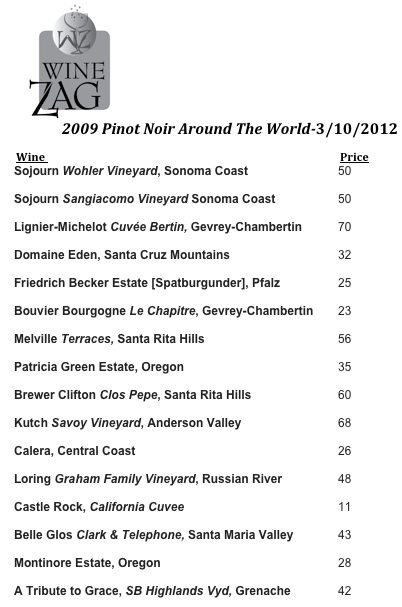 Blind tasting seventeen different examples of 2009 pinot noir in one sitting was repeated evidence, inside twenty five years of steady reminders, that side-by-side peer group blind tasting is the most legitimate format to learn about wine and your personal palate. In Robert Dwyer’s opening paragraphs of his detailed Wellesley Wine Press tasting note post on this pinot noir extravaganza that our Boston group recently submitted itself to, he gets right to the points of eliminating bias and assumption.
Blind tasting seventeen different examples of 2009 pinot noir in one sitting was repeated evidence, inside twenty five years of steady reminders, that side-by-side peer group blind tasting is the most legitimate format to learn about wine and your personal palate. In Robert Dwyer’s opening paragraphs of his detailed Wellesley Wine Press tasting note post on this pinot noir extravaganza that our Boston group recently submitted itself to, he gets right to the points of eliminating bias and assumption.
If we can all agree that wine is meant to be enjoyed and not idolized according to label, then blind tasting remains the purest way to test your susceptibility to this sort of predilection in a totally controlled way. California enjoyed a great pinot noir vintage in 2009 and Robert and the rest of us had favorites we already tasted unblind, one at a time. How would they stack up next to Italian, French, German, and other domestic versions? It is a scary naked moment for passionate wine drinkers with knowledgeable edges.
The wines came from the Sonoma coast, Santa Cruz Mountains, Santa Rita Hills, Anderson Valley, Russian River, Santa Maria Valley, Oregon, Pfalz, Gevrey-Chambertin, and Pavia. I even threw in a ringer grenache from the Santa Barbara Highlands that I swore had the coloration and other characteristics of pinot noir when I tasted it individually three different times (2009 A Tribute to Grace Santa Barbara Highlands Vineyard grenache). A late entry, and not on the list above, was the Calatroni 2010 pinot nero. Guess what?
 With all votes cast blind, the Calatroni at $18 from Italy’s Lombardy wine region tied with the $60 Brewer Clifton Clos Pepe as the group’s favorite wine. Also, the Bouvier Bourgogne at $23 tied the $50 Soujourn Wohler Vineyard for second place. Finally, I was the only person (mainly by color and with the certain advantage of having tasted it before) that was able to pick the grenache out of this all-pinot noir group, and it finished in a 3rd place tie with the $26 Calera. The $11 Castle Rock was one of four wines that finished tied at the bottom of the voting results, along with the Loring, Belle Glos, and Becker from Germany.
With all votes cast blind, the Calatroni at $18 from Italy’s Lombardy wine region tied with the $60 Brewer Clifton Clos Pepe as the group’s favorite wine. Also, the Bouvier Bourgogne at $23 tied the $50 Soujourn Wohler Vineyard for second place. Finally, I was the only person (mainly by color and with the certain advantage of having tasted it before) that was able to pick the grenache out of this all-pinot noir group, and it finished in a 3rd place tie with the $26 Calera. The $11 Castle Rock was one of four wines that finished tied at the bottom of the voting results, along with the Loring, Belle Glos, and Becker from Germany.
Robert’s post offers intensive tasting notes, so I will spare mine, as different as they might be. I am not surprised the Brewer-Clifton took a top spot. The pinots from the Santa Rita Hills are so impressive in most vintages. Velvet, pretty, round, richly fruited wines that never feel heavy hail from this growing region and the 2009 Brewer-Clifton Clos Pepe held true. The Calatroni was sheer prettiness with complex flavors, aromas, and old world styling. It is utterly amazing that this wine is available in the US for $15-$18. Another great value in second place came from France; Bouvier Bourgogne Le Chapitre. It was full of coffee, leather, and attractive gaminess. In third place, but my second place wine, was the Calera. Medium dark, rich black cherry flavor, herbs, toast, and soy were all in full evidence. I can not recommend these four wines enough. Lastly, the grenache made by Angela Osborne is a new take on the variety that I have never witnessed in California. Light, graceful as in its namesake….it was able to disguise itself as pinot noir. If you can get your hands on Angela’s wines, you won’t go wrong.
These blind tasting results pointed to value in the US and Europe. Their worthiness would never have been placed in such supportive context for me without the blind tasting event. I continue to learn.